Microencapsulation of Propolis by Complex Coacervation with Chia Mucilage and Gelatin: Antioxidant Stability and Functional Potential
Abstract
1. Introduction
2. Materials and Methods
2.1. Materials
2.2. Extraction of Chia Mucilage
2.3. Obtaining the Ethanolic Extract of Propolis
2.4. Microencapsulation by Complex Coacervation
2.5. Preparation of Ethanolic and Methanolic Extracts for Bioactive Compound Analysis
2.6. Determination of Total Phenolic Compounds
2.7. Determination of Flavonoids
2.8. Determination of Antioxidant Capacity by the DPPH Method
2.9. Determination of Antioxidant Capacity by the ABTS Method
2.10. Color Determination
2.11. Moisture Determination
2.12. Hygroscopicity Determination
2.13. Bulk Density Determination
2.14. Solubility Determination
2.15. Particle Size Determination
2.16. ζ Potential Determination
2.17. In Vitro Release Evaluation of Phenolic Compounds
2.18. Scanning Electron Microscopy (SEM) Analysis
2.19. Fourier Transform Infrared (FTIR) Spectroscopy Analysis
2.20. Thermogravimetric Analysis (TGA)
2.21. Differential Scanning Calorimetry (DSC)
2.22. Ultra-High-Performance Liquid Chromatography Analysis (UPLC-PDA-QDa)
2.23. Incorporation into Gummy Candies
2.24. Sensory Evaluation
2.25. Texture Profile Analysis (TPA)
2.26. Statistical Analysis
3. Results and Discussions
3.1. Characterization of Raw Propolis and Ethanolic Propolis Extract
3.2. Characterization of Wall Materials
3.3. Physicochemical Properties of Microcapsules Obtained by Complex Coacervation and Spray Drying
3.4. Identification and Quantification of Phenolic Compounds in the Optimal Treatment
3.5. Morphological, Structural, and Thermal Evaluation of the Optimal Treatment
3.6. In Vitro Release of Phenolic Compounds
3.7. Incorporation of Microcapsules into Functional Gummy Candies
4. Conclusions
Author Contributions
Funding
Institutional Review Board Statement
Informed Consent Statement
Data Availability Statement
Acknowledgments
Conflicts of Interest
References
- Braakhuis, A. Evidence on the Health Benefits of Supplemental Propolis. Nutrients 2019, 11, 2705. [Google Scholar] [CrossRef]
- Chavda, V.P.; Vuppu, S.; Balar, P.C.; Mishra, T.; Bezbaruah, R.; Teli, D.; Sharma, N.; Alom, S. Propolis in the management of cardiovascular disease. Int. J. Biol. Macromol. 2024, 266, 131219. [Google Scholar] [CrossRef]
- Pasupuleti, V.R.; Sammugam, L.; Ramesh, N.; Gan, S.H. Honey, Propolis, and Royal Jelly: A Comprehensive Review of Their Biological Actions and Health Benefits. Oxidative Med. Cell. Longev. 2017, 2017, 1259510. [Google Scholar] [CrossRef]
- Ligarda-Samanez, C.A.; Choque-Quispe, D.; Moscoso-Moscoso, E.; Huamán-Carrión, M.L.; Ramos-Pacheco, B.S.; Peralta-Guevara, D.E.; Cruz, G.D.; Martínez-Huamán, E.L.; Arévalo-Quijano, J.C.; Muñoz-Saenz, J.C.; et al. Obtaining and Characterizing Andean Multi-Floral Propolis Nanoencapsulates in Polymeric Matrices. Foods 2022, 11, 3153. [Google Scholar] [CrossRef]
- Jansen-Alves, C.; Martins Fonseca, L.; Doring Krumreich, F.; Zavareze, E.D.R. Applications of propolis encapsulation in food products. J. Microencapsul. 2023, 40, 567–586. [Google Scholar] [CrossRef]
- Ligarda-Samanez, C.A.; Choque-Quispe, D.; Moscoso-Moscoso, E.; Huamán-Carrión, M.L.; Ramos-Pacheco, B.S.; De la Cruz, G.; Arévalo-Quijano, J.C.; Muñoz-Saenz, J.C.; Muñoz-Melgarejo, M.; Quispe-Quezada, U.R.; et al. Microencapsulation of Propolis and Honey Using Mixtures of Maltodextrin/Tara Gum and Modified Native Potato Starch/Tara Gum. Foods 2023, 12, 1873. [Google Scholar] [CrossRef]
- Tavares, L.; Smaoui, S.; Lima, P.S.; de Oliveira, M.M.; Santos, L. Propolis: Encapsulation and application in the food and pharmaceutical industries. Trends Food Sci. Technol. 2022, 127, 169–180. [Google Scholar] [CrossRef]
- Maroof, K.; Lee, R.S.F.; Siow, S.F.; Gan, S.H. Microencapsulation of propolis by spray drying: A review. Dry. Technol. 2022, 40, 1083–1102. [Google Scholar] [CrossRef]
- Muhoza, B.; Yuyang, H.; Uriho, A.; Harindintwali, J.D.; Liu, Q.; Li, Y. Spray-and freeze-drying of microcapsules prepared by complex coacervation method: A review. Food Hydrocoll. 2023, 140, 108650. [Google Scholar] [CrossRef]
- Sukri, N.; Marin, P.T.T.; Mahani; Nurhadi, B. Characteristics of propolis encapsulated with gelatin and sodium alginate by complex coacervation method. Int. J. Food Prop. 2023, 26, 696–707. [Google Scholar] [CrossRef]
- Hernández-Nava, R.; López-Malo, A.; Palou, E.; Ramírez-Corona, N.; Jiménez-Munguía, M.T. Encapsulation of oregano essential oil (Origanum vulgare) by complex coacervation between gelatin and chia mucilage and its properties after spray drying. Food Hydrocoll. 2020, 109, 106077. [Google Scholar] [CrossRef]
- Hernández-Nava, R.; López-Malo, A.; Palou, E.; Ramírez-Corona, N.; Jiménez-Munguía, M.T. Complex Coacervation Between Gelatin and Chia Mucilage as an Alternative of Encapsulating Agents. J. Food Sci. 2019, 84, 1281–1287. [Google Scholar] [CrossRef]
- Bustamante, M.; Laurie-Martínez, L.; Vergara, D.; Campos-Vega, R.; Rubilar, M.; Shene, C. Effect of Three Polysaccharides (Inulin, and Mucilage from Chia and Flax Seeds) on the Survival of Probiotic Bacteria Encapsulated by Spray Drying. Appl. Sci. 2020, 10, 4623. [Google Scholar] [CrossRef]
- Busch, V.M.; Pereyra-Gonzalez, A.; Šegatin, N.; Santagapita, P.R.; Poklar Ulrih, N.; Buera, M.P. Propolis encapsulation by spray drying: Characterization and stability. LWT 2017, 75, 227–235. [Google Scholar] [CrossRef]
- Kurek-Górecka, A.; Kara, Y.; Pokajewicz, K.; Ben Hammouda, I.; Wieczorek, P.P.; Marciniak, D.; Balwierz, R.; Kłósek, M.; Czuba, Z.P.; Kolaylı, S. Phenolic content, volatile compounds and antioxidant activity in pooled propolis samples from Turkey and Poland. Eur. Food Res. Technol. 2025. [Google Scholar] [CrossRef]
- Ligarda-Samanez, C.A.; Choque-Quispe, D.; Moscoso-Moscoso, E.; Pozo, L.M.F.; Ramos-Pacheco, B.S.; Palomino-Rincón, H.; Gutiérrez, R.J.G.; Peralta-Guevara, D.E. Effect of Inlet Air Temperature and Quinoa Starch/Gum Arabic Ratio on Nanoencapsulation of Bioactive Compounds from Andean Potato Cultivars by Spray-Drying. Molecules 2023, 28, 7875. [Google Scholar] [CrossRef] [PubMed]
- Ligarda-Samanez, C.A.; Choque-Quispe, D.; Moscoso-Moscoso, E.; Palomino-Rincón, H.; Taipe-Pardo, F.; Aguirre Landa, J.P.; Arévalo-Quijano, J.C.; Muñoz-Saenz, J.C.; Quispe-Quezada, U.R.; Huamán-Carrión, M.L.; et al. Nanoencapsulation of Phenolic Extracts from Native Potato Clones (Solanum tuberosum spp. andigena) by Spray Drying. Molecules 2023, 28, 4961. [Google Scholar] [CrossRef]
- Ligarda-Samanez, C.A.; Palomino-Rincón, H.; Choque-Quispe, D.; Moscoso-Moscoso, E.; Arévalo-Quijano, J.C.; Huamán-Carrión, M.L.; Quispe-Quezada, U.R.; Muñoz-Saenz, J.C.; Gutiérrez-Gómez, E.; Cabel-Moscoso, D.J.; et al. Bioactive Compounds and Sensory Quality in Chips of Native Potato Clones (Solanum tuberosum spp. andigena) Grown in the High Andean Region of PERU. Foods 2023, 12, 2511. [Google Scholar] [CrossRef]
- Moscoso-Moscoso, E.; Ligarda-Samanez, C.A.; Choque-Quispe, D.; Huamán-Carrión, M.L.; Arévalo-Quijano, J.C.; De la Cruz, G.; Luciano-Alipio, R.; Calsina Ponce, W.C.; Sucari-León, R.; Quispe-Quezada, U.R.; et al. Preliminary Assessment of Tara Gum as a Wall Material: Physicochemical, Structural, Thermal, and Rheological Analyses of Different Drying Methods. Polymers 2024, 16, 838. [Google Scholar] [CrossRef]
- Berretta, A.A.; Zamarrenho, L.G.; Correa, J.A.; De Lima, J.A.; Borini, G.B.; Ambrósio, S.R.; Barud, H.D.; Bastos, J.K.; De Jong, D. Development and Characterization of New Green Propolis Extract Formulations as Promising Candidates to Substitute for Green Propolis Hydroalcoholic Extract. Molecules 2023, 28, 3510. [Google Scholar] [CrossRef]
- Andrade, J.K.S.; Denadai, M.; Andrade, G.R.S.; da Cunha Nascimento, C.; Barbosa, P.F.; Jesus, M.S.; Narain, N. Development and characterization of microencapsules containing spray dried powder obtained from Brazilian brown, green and red propolis. Food Res. Int. 2018, 109, 278–287. [Google Scholar] [CrossRef]
- Andrade, J.K.S.; Denadai, M.; de Oliveira, C.S.; Nunes, M.L.; Narain, N. Evaluation of bioactive compounds potential and antioxidant activity of brown, green and red propolis from Brazilian northeast region. Food Res. Int. 2017, 101, 129–138. [Google Scholar] [CrossRef] [PubMed]
- Ligarda-Samanez, C.A.; Villano-Limache, E.; Pichihua-Oscco, W.; Choque-Quispe, D.; Sucari-León, R.; Calderón Huamaní, D.F.; Cruz, G.D.; Luciano-Alipio, R.; Calsina Ponce, W.C.; Aroquipa-Durán, Y.; et al. Physicochemical and Sensory Evaluation of Gummy Candies Fortified with Microcapsules of Guinea Pig (Cavia porcellus) Blood Erythrocytes and Tumbo (Passiflora tarminiana) Juice. Appl. Sci. 2025, 15, 917. [Google Scholar] [CrossRef]
- Tumbarski, Y.; Ivanov, I.; Todorova, M.; Apostolova, S.; Tzoneva, R.; Nikolova, K. Phenolic Content, Antioxidant Activity and In Vitro Anti-Inflammatory and Antitumor Potential of Selected Bulgarian Propolis Samples. Biomedicines 2025, 13, 334. [Google Scholar] [CrossRef]
- Rosales-Chimal, S.; Navarro-Cortez, R.O.; Bello-Perez, L.A.; Vargas-Torres, A.; Palma-Rodríguez, H.M. Optimal conditions for anthocyanin extract microencapsulation in taro starch: Physicochemical characterization and bioaccessibility in gastrointestinal conditions. Int. J. Biol. Macromol. 2023, 227, 83–92. [Google Scholar] [CrossRef] [PubMed]
- Das, A.B.; Goud, V.V.; Das, C. Microencapsulation of anthocyanin extract from purple rice bran using modified rice starch and its effect on rice dough rheology. Int. J. Biol. Macromol. 2019, 124, 573–581. [Google Scholar] [CrossRef] [PubMed]
- Pedrozo, R.C.; Antônio, E.; Khalil, N.M.; Mainardes, R.M. Bovine serum albumin-based nanoparticles containing the flavonoid rutin produced by nano spray drying. Braz. J. Pharm. Sci. 2020, 56, e17692. [Google Scholar] [CrossRef]
- Mousavi Kalajahi, S.E.; Ghandiha, S. Optimization of spray drying parameters for encapsulation of Nettle (Urtica dioica L.) extract. LWT 2022, 158, 113149. [Google Scholar] [CrossRef]
- Kyriakoudi, A.; Tsimidou, M.Z. Properties of encapsulated saffron extracts in maltodextrin using the Büchi B-90 nano spray-dryer. Food Chem. 2018, 266, 458–465. [Google Scholar] [CrossRef]
- Nayak, C.A.; Rastogi, N.K. Effect of Selected Additives on Microencapsulation of Anthocyanin by Spray Drying. Dry. Technol. 2010, 28, 1396–1404. [Google Scholar] [CrossRef]
- Vergara, C.; Pino, M.T.; Zamora, O.; Parada, J.; Pérez, R.; Uribe, M.; Kalazich, J. Microencapsulation of Anthocyanin Extracted from Purple Flesh Cultivated Potatoes by Spray Drying and Its Effects on In Vitro Gastrointestinal Digestion. Molecules 2020, 25, 722. [Google Scholar] [CrossRef]
- Bezerra, M.A.; Santelli, R.E.; Oliveira, E.P.; Villar, L.S.; Escaleira, L.A. Response surface methodology (RSM) as a tool for optimization in analytical chemistry. Talanta 2008, 76, 965–977. [Google Scholar] [CrossRef] [PubMed]
- Duca, A.; Sturza, A.; Moacă, E.-A.; Negrea, M.; Lalescu, V.-D.; Lungeanu, D.; Dehelean, C.-A.; Muntean, D.-M.; Alexa, E. Identification of Resveratrol as Bioactive Compound of Propolis from Western Romania and Characterization of Phenolic Profile and Antioxidant Activity of Ethanolic Extracts. Molecules 2019, 24, 3368. [Google Scholar] [CrossRef] [PubMed]
- Volpi, N. Separation of flavonoids and phenolic acids from propolis by capillary zone electrophoresis. Electrophoresis 2004, 25, 1872–1878. [Google Scholar] [CrossRef]
- Rocha, V.M.; Portela, R.W.; Lacerda, L.E.; Sokolonski, A.R.; de Souza, C.O.; dos Anjos, J.P.; Nascimento, R.Q.; Umsza-Guez, M.A. Propolis from different Brazilian stingless bee species: Phenolic composition and antimicrobial activity. Food Prod. Process. Nutr. 2023, 6, 12. [Google Scholar] [CrossRef]
- Huang, S.; Zhang, C.-P.; Wang, K.; Li, G.Q.; Hu, F.-L. Recent Advances in the Chemical Composition of Propolis. Molecules 2014, 19, 19610–19632. [Google Scholar] [CrossRef]
- Freitas, M.O.; Ponte, F.A.; Lima, M.A.S.; Silveira, E.R. Flavonoids and triterpenes from the nest of the stingless bee Trigona spinipes. J. Braz. Chem. Soc. 2008, 19, 532–535. [Google Scholar] [CrossRef]
- Heng, D.; Lee, S.H.; Ng, W.K.; Tan, R.B.H. The nano spray dryer B-90. Expert Opin. Drug Deliv. 2011, 8, 965–972. [Google Scholar] [CrossRef]
- Delia, S.-C.; Chávez, G.M.; León-Martínez Frank, M.; Araceli, S.-G.P.; Irais, A.-L.; Franco, A.-A. Spray drying microencapsulation of betalain rich extracts from Escontria chiotilla and Stenocereus queretaroensis fruits using cactus mucilage. Food Chem. 2019, 272, 715–722. [Google Scholar] [CrossRef]
- Pashazadeh, H.; Zannou, O.; Ghellam, M.; Koca, I.; Galanakis, C.M.; Aldawoud, T.M.S. Optimization and Encapsulation of Phenolic Compounds Extracted from Maize Waste by Freeze-Drying, Spray-Drying, and Microwave-Drying Using Maltodextrin. Foods 2021, 10, 1396. [Google Scholar] [CrossRef]
- Fredes, C.; Becerra, C.; Parada, J.; Robert, P. The Microencapsulation of Maqui (Aristotelia chilensis (Mol.) Stuntz) Juice by Spray-Drying and Freeze-Drying Produces Powders with Similar Anthocyanin Stability and Bioaccessibility. Molecules 2018, 23, 1227. [Google Scholar] [CrossRef]
- Cedeño-Pinos, C.; Marcucci, M.C.; Bañón, S. Contribution of Green Propolis to the Antioxidant, Physical, and Sensory Properties of Fruity Jelly Candies Made with Sugars or Fructans. Foods 2021, 10, 2586. [Google Scholar] [CrossRef] [PubMed]
- Calderón-Oliver, M.; Ponce-Alquicira, E. The Role of Microencapsulation in Food Application. Molecules 2022, 27, 1499. [Google Scholar] [CrossRef] [PubMed]
- Otálora, M.C.; Wilches-Torres, A.; Gómez Castaño, J.A. Microencapsulation of Betaxanthin Pigments from Pitahaya (Hylocereus megalanthus) By-Products: Characterization, Food Application, Stability, and In Vitro Gastrointestinal Digestion. Foods 2023, 12, 2700. [Google Scholar] [CrossRef]
- González-Montiel, L.; Miranda-Altamirano, D.; Bautista-Marcial, A.S.; Güemes-Vera, N.; Soto-Simental, S.; Franco-Fernández, M.J.; Sánchez-Hernández, C.; Campos-Pastelín, J.M. Análisis de perfil de textura y color en gomitas elaboradas a partir de una deccoción de plantas medicinales. Investig. Desarro. Cienc. Tecnol. Aliment. 2019, 1, 756–760. [Google Scholar]
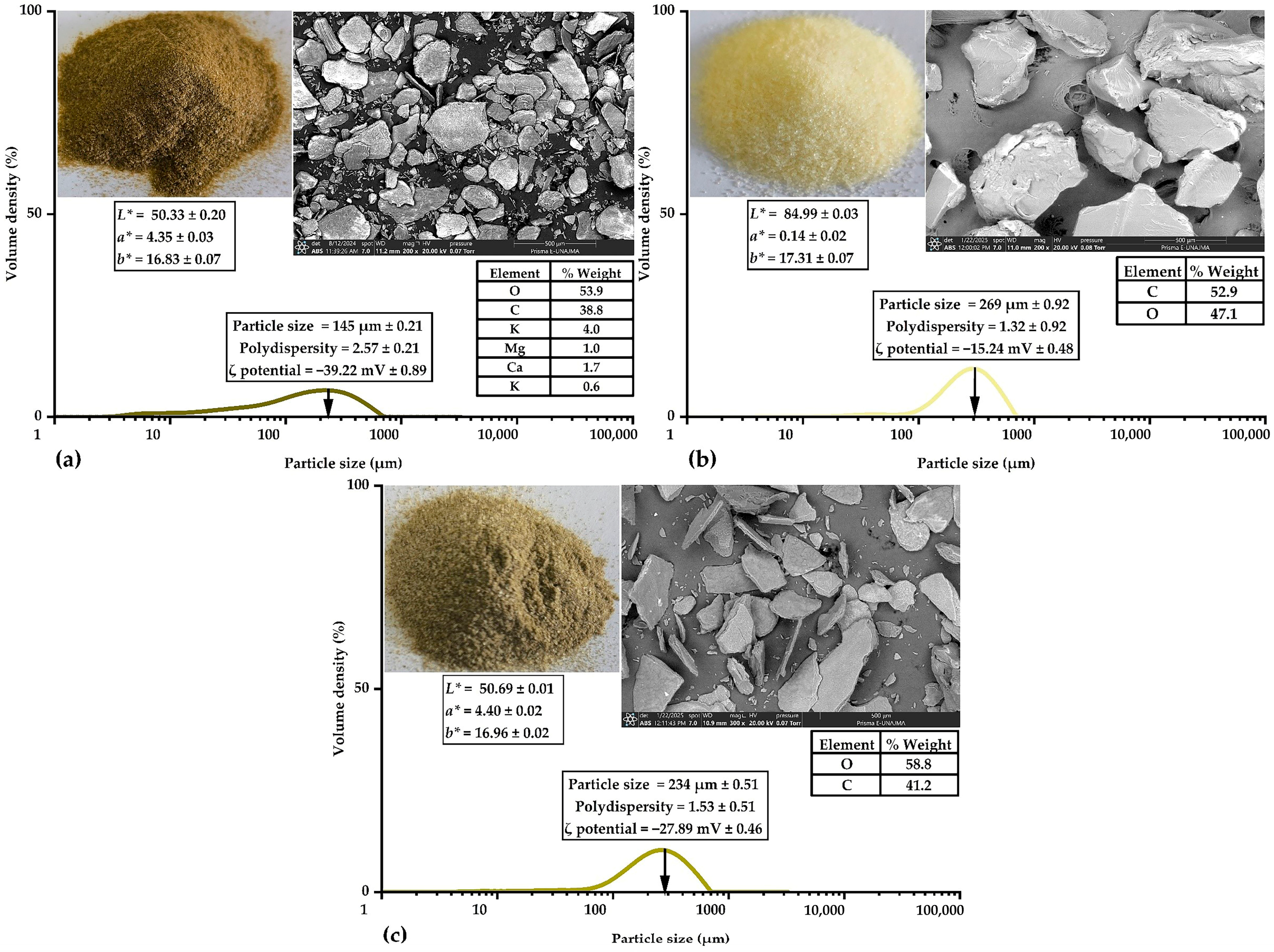
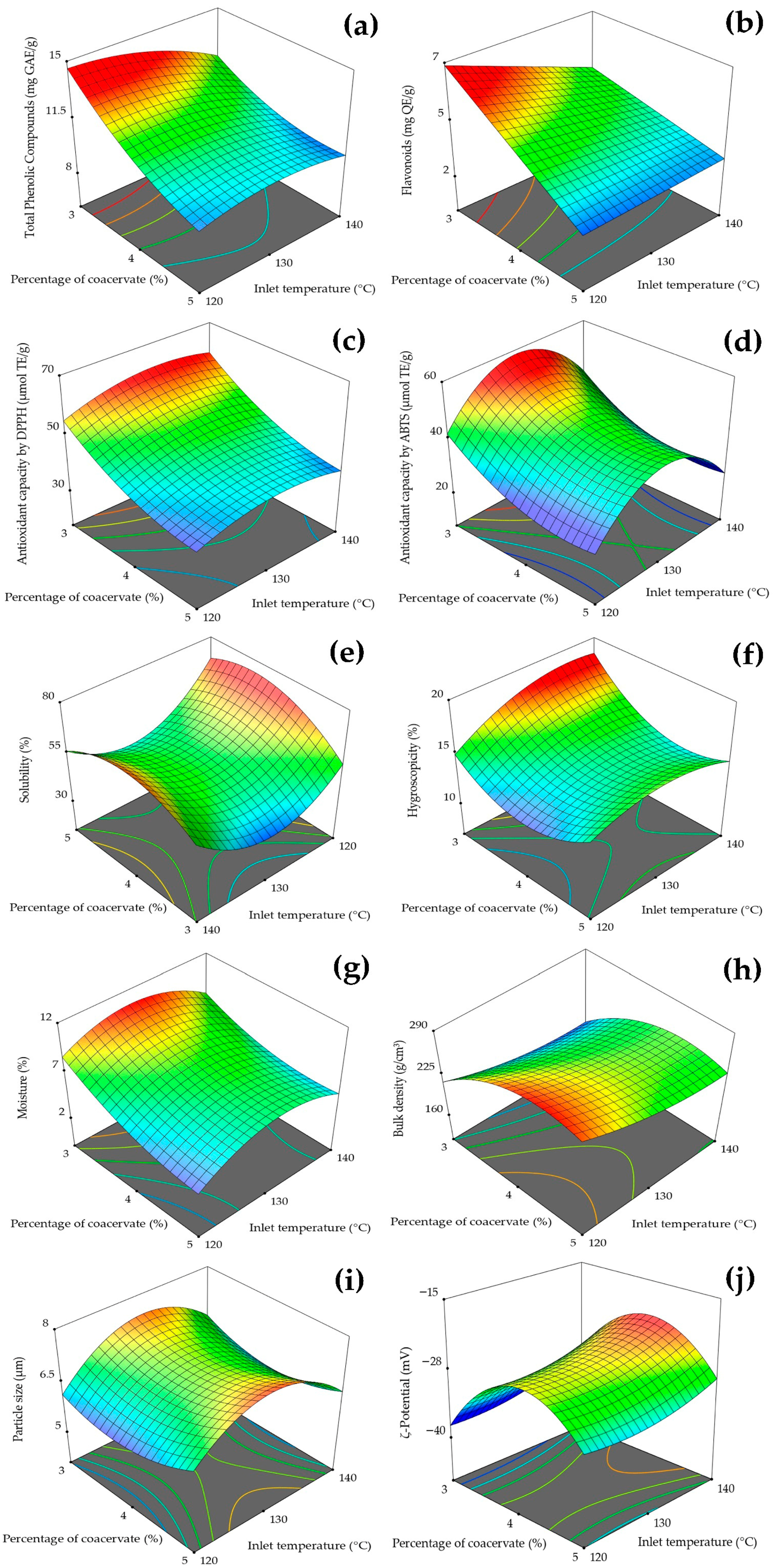
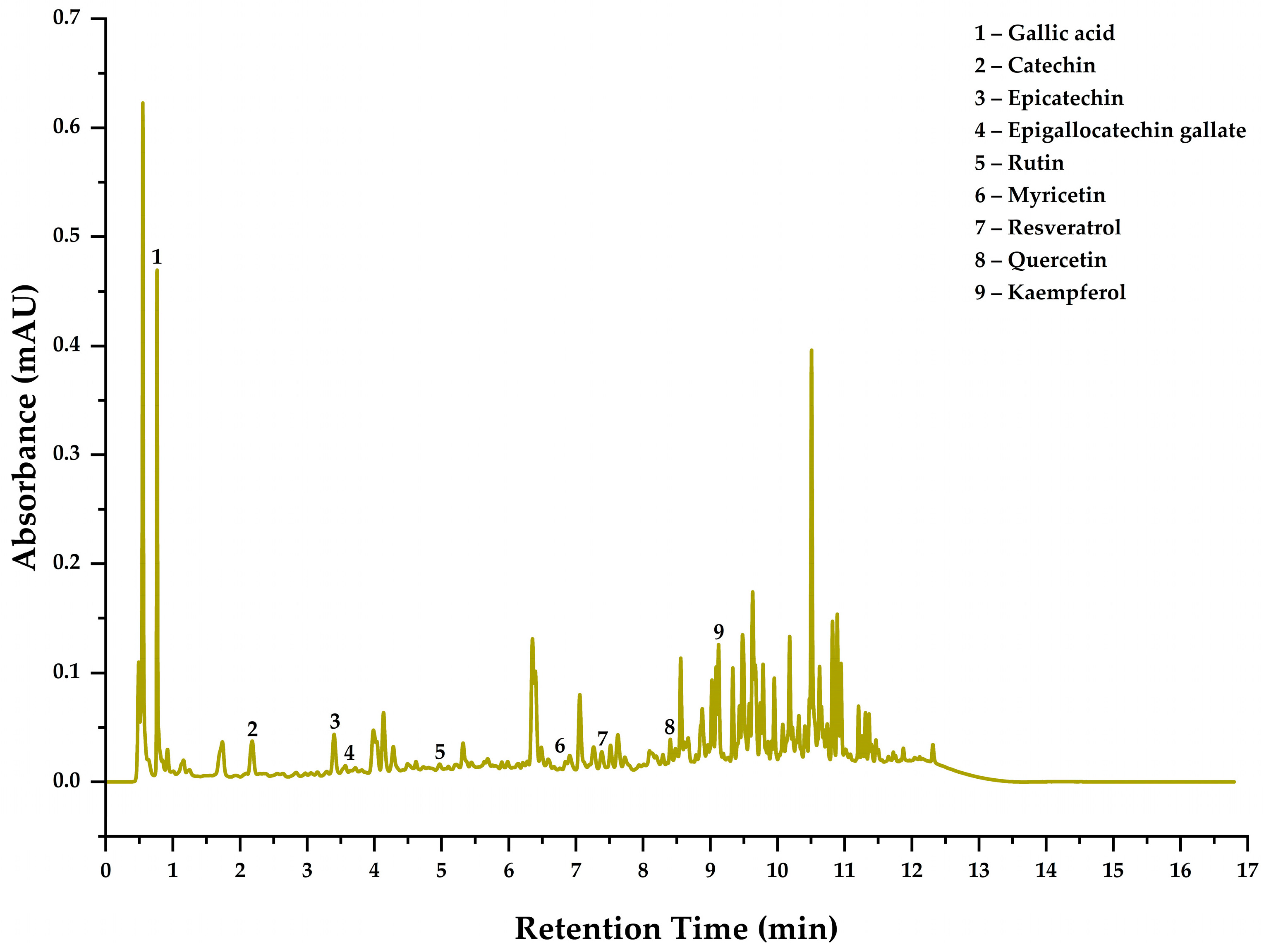
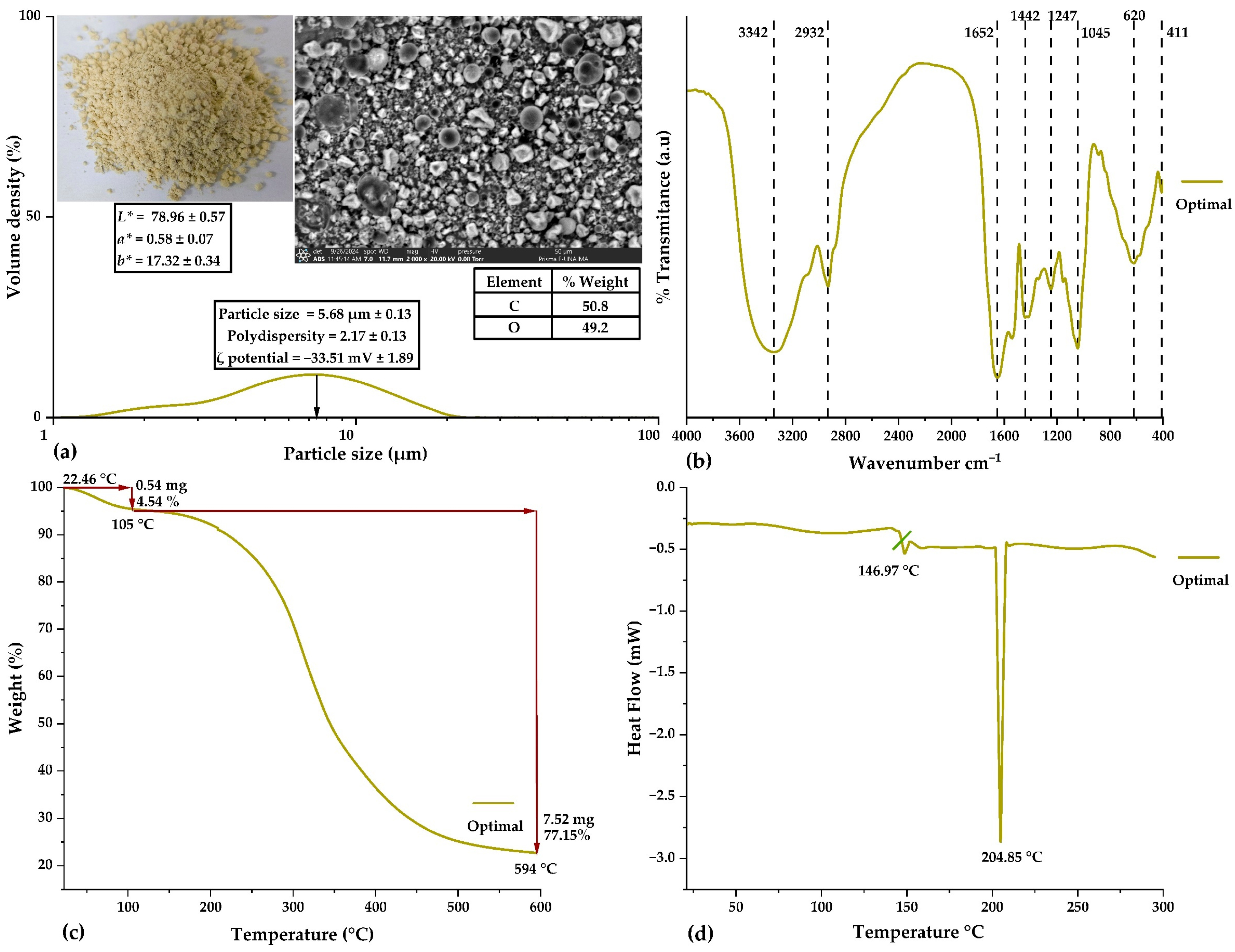
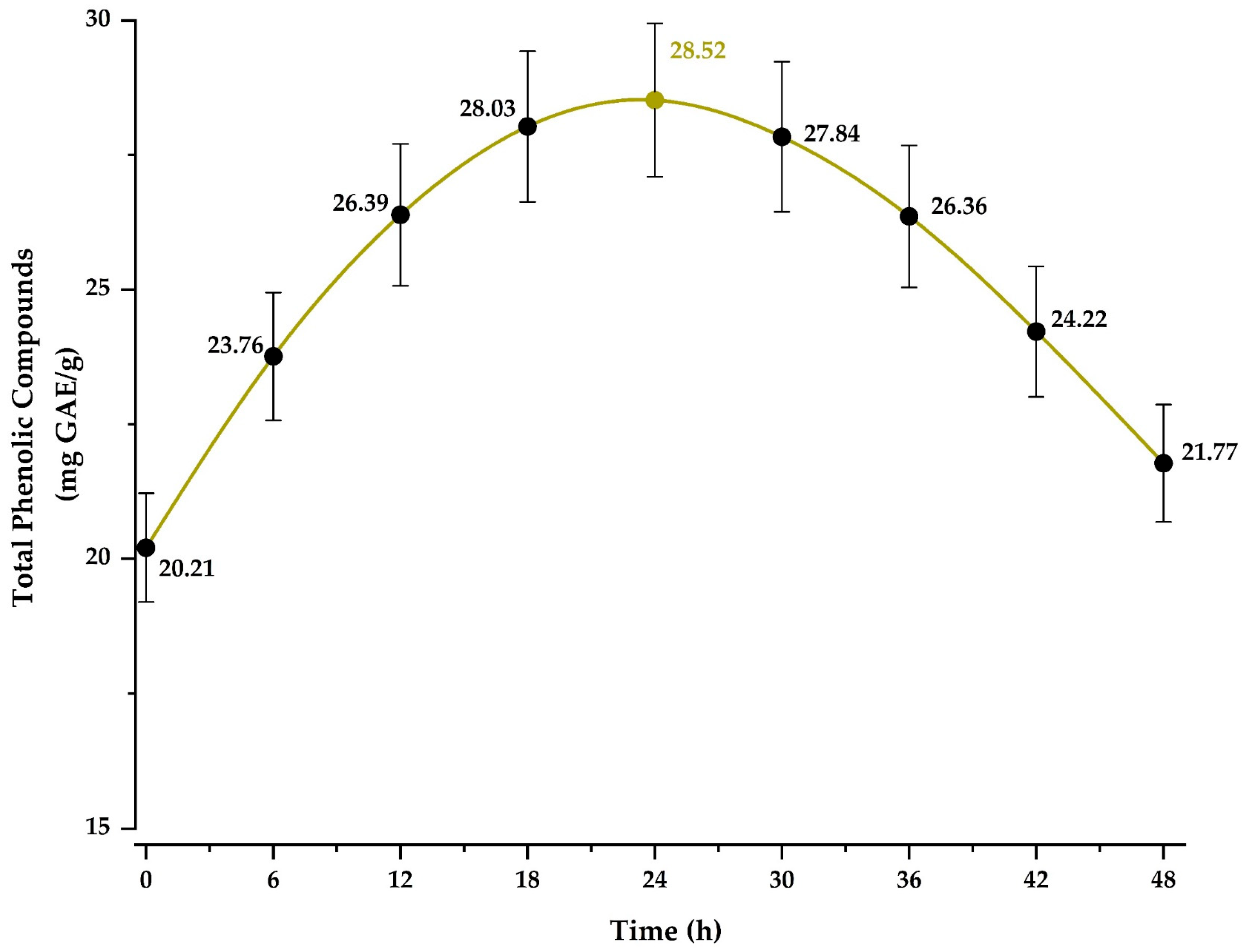
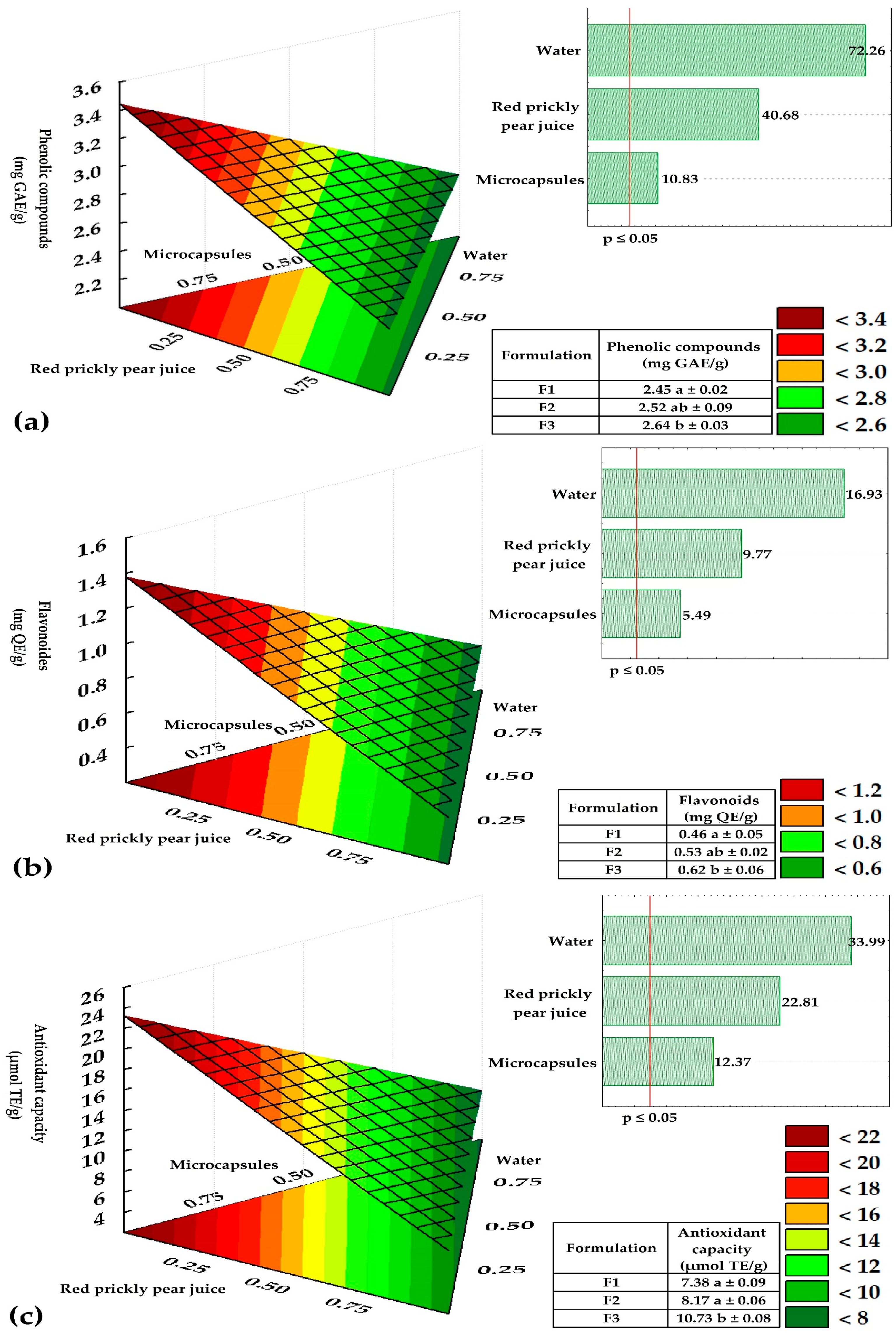

| Formulation | Microcapsules | Red Cactus Pear Juice | Water | Neutral Gelatin (200° Bloom) | Sucrose | Glucose | Isomaltose | Potassium Benzoate | Glycerin |
|---|---|---|---|---|---|---|---|---|---|
| F1 | 3.00% | 35.00% | 16.50% | 11.00% | 11.00% | 17.00% | 5.00% | 1.00% | 0.50% |
| F2 | 4.00% | 30.00% | 20.50% | 11.00% | 11.00% | 17.00% | 5.00% | 1.00% | 0.50% |
| F3 | 5.00% | 40.00% | 9.50% | 11.00% | 11.00% | 17.00% | 5.00% | 1.00% | 0.50% |
| Property | Raw Propolis | Ethanolic Extract of Propolis | ||||
|---|---|---|---|---|---|---|
| ± | SD | ± | SD | |||
| Phenolic compounds (mg GAE/g) | 6.48 a | ± | 0.15 | 17.66 b | ± | 0.05 |
| Flavonoids (mg QE/g) | 6.07 a | ± | 0.18 | 13.72 b | ± | 0.63 |
| Antioxidant capacity by DPPH (µmol TE/g) | 45.48 a | ± | 0.08 | 102.88 b | ± | 0.46 |
| L* | 33.73 a | ± | 0.01 | 41.98 b | ± | 0.25 |
| a* | 3.97 a | ± | 0.04 | 16.92 b | ± | 0.05 |
| b* | 9.21 a | ± | 0.07 | 66.27 b | ± | 0.37 |
| Run | A | B | Phenolic Compounds | Flavonoids | DPPH | ABTS | Solubility | Hygroscopicity | Moisture | Bulk Density | Particle Size | ζ Potential |
|---|---|---|---|---|---|---|---|---|---|---|---|---|
| % | °C | mg GAE/g | mg QE/g | µmol TE/g | µmol TE/g | % | % | % | g/mL | µm | mV | |
| ± SD | ± SD | ± SD | ± SD | ± SD | ± SD | ± SD | ± SD | ± SD | ± SD | |||
| T1 | 3 | 120 | 15.36 ± 0.57 | 7.77 ± 0.93 | 56.25 ± 1.98 | 46.33 ± 0.12 | 49.64 ± 0.00 | 15.83 ± 0.68 | 9.57 ± 0.00 | 206.71 ± 0.00 | 6.41 ± 0.03 | −34.23 ± 1.55 |
| T2 | 4 | 120 | 10.41 ± 0.06 | 3.83 ± 0.07 | 40.79 ± 1.96 | 25.65 ± 0.71 | 79.72 ± 0.00 | 13.08 ± 0.79 | 5.10 ± 0.10 | 284.25 ± 0.00 | 5.39 ± 0.09 | −30.30 ± 2.32 |
| T3 | 5 | 120 | 9.84 ± 0.18 | 3.62 ± 0.21 | 36.78 ± 1.47 | 23.09 ± 0.19 | 66.80 ± 0.00 | 12.58 ± 1.11 | 2.70 ± 0.20 | 274.50 ± 0.00 | 6.66 ± 0.06 | −31.27 ± 0.94 |
| T4 | 3 | 130 | 13.12 ± 0.23 | 5.18 ± 0.20 | 60.10 ± 1.99 | 50.10 ± 0.07 | 41.49 ± 0.00 | 15.23 ± 0.07 | 8.52 ± 0.00 | 197.07 ± 0.00 | 6.90 ± 0.09 | −37.29 ± 1.89 |
| T5 | 4 | 130 | 11.71 ± 0.12 | 3.79 ± 0.61 | 47.34 ± 1.35 | 46.75 ± 0.07 | 44.30 ± 0.00 | 14.65 ± 1.15 | 7.67 ± 0.00 | 238.07 ± 0.00 | 7.80 ± 0.03 | −29.25 ± 2.42 |
| T6 | 5 | 130 | 10.77 ± 0.38 | 2.67 ± 0.07 | 44.53 ± 1.36 | 47.98 ± 0.58 | 47.39 ± 0.00 | 18.54 ± 0.70 | 8.62 ± 0.00 | 239.56 ± 0.00 | 7.23 ± 0.07 | −28.05 ± 0.95 |
| T7 | 3 | 140 | 11.92 ± 0.47 | 4.31 ± 0.14 | 59.38 ± 0.35 | 45.45 ± 0.32 | 53.90 ± 0.00 | 20.50 ± 1.67 | 8.99 ± 0.00 | 177.75 ± 0.00 | 6.83 ± 0.04 | −34.78 ± 1.57 |
| T8 | 4 | 140 | 10.83 ± 0.28 | 4.72 ± 0.18 | 47.04 ± 2.43 | 25.79 ± 0.21 | 67.53 ± 0.00 | 12.72 ± 0.92 | 5.34 ± 0.46 | 237.75 ± 0.00 | 5.64 ± 0.02 | −13.20 ± 0.75 |
| T9 | 5 | 140 | 9.16 ± 0.95 | 2.80 ± 0.48 | 37.89 ± 2.83 | 22.19 ± 0.09 | 56.67 ± 0.00 | 13.65 ± 0.62 | 4.29 ± 0.45 | 234.55 ± 0.00 | 6.59 ± 0.07 | −34.63 ± 0.96 |
| Parameter | p-Value Model | R2 | Intercept | A | B | AB | A2 | B2 |
|---|---|---|---|---|---|---|---|---|
| Phenolic compounds | <0.0001 | 0.85 | 11.39 | −1.77 * | −0.62 * | 0.69 * | 0.71 * | −0.61 |
| p-values | <0.0001 | 0.004 | 0.01 | 0.04 | 0.08 | |||
| Flavonoids | <0.0001 | 0.79 | 4.30 | −1.36 * | −0.56 * | 0.66 * | 0.28 | 0.63 |
| p-values | <0.0001 | 0.008 | 0.01 | 0.39 | 0.06 | |||
| DPPH | <0.0001 | 0.95 | 47.93 | −9.42 * | 1.75 * | −0.50 | 4.10 * | −4.30 * |
| p-values | <0.0001 | 0.004 | 0.45 | 0.0002 | 0.0001 | |||
| ABTS | <0.0001 | 0.86 | 43.97 | −8.10 * | −0.27 | −0.003 | 6.46 * | −16.86 * |
| p-values | <0.0001 | 0.82 | 0.99 | 0.004 | <0.0001 | |||
| Solubility | <0.0001 | 0.87 | 51.86 | 4.31 * | −3.01 * | −3.60 * | −11.20 * | 17.98 * |
| p-values | 0.001 | 0.02 | 0.02 | <0.0001 | <0.0001 | |||
| Hygroscopicity | 0.008 | 0.51 | 14.43 | −1.13 * | 0.90 | −0.90 | 2.57 * | −1.41 |
| p-values | 0.04 | 0.10 | 0.16 | 0.008 | 0.12 | |||
| Moisture | <0.0001 | 0.75 | 7.55 | −1.91 * | 0.21 | 0.54 | 1.08 | −2.27 * |
| p-values | <0.0001 | 0.51 | 0.17 | 0.06 | 0.0003 | |||
| Bulk density | <0.0001 | 0.97 | 246.01 | 27.85 * | −19.24 * | −2.75 | −31.67 * | 11.02 * |
| p-values | <0.0001 | <0.0001 | 0.18 | <0.0001 | 0.0007 | |||
| Particle size | 0.0003 | 0.65 | 6.98 | 0.06 | 0.10 | −0.12 | 0.50 * | −1.06 * |
| p-values | 0.62 | 0.38 | 0.39 | 0.02 | <0.0001 | |||
| ζ-Potential | 0.0032 | 0.55 | −25.45 | 2.06 | 2.20 | −0.70 | −9.12 * | 1.80 |
| p-values | 0.12 | 0.09 | 0.64 | 0.0003 | 0.41 |
| Variable | Experimental Range | Optimal Value | Desirability | ||||
|---|---|---|---|---|---|---|---|
| Independent variables | Low | High | |||||
| A: Percentage of coacervate (%) | 3 | 5 | 3.13 | 0.59 | |||
| B: Inlet temperature (°C) | 120 | 140 | 120 | ||||
| Dependent variables | Low | High | 95% PI low | Experimental value | 95% PI high | Predicted value | Assertiveness |
| Phenolic compounds (mg GAE/g) | 9.16 | 15.36 | 13.00 | 14.26 ± 0.15 | 15.00 | 14.00 | 98% |
| Flavonoids (mg QE/g) | 2.67 | 7.77 | 5.38 | 6.09 ± 0.56 | 7.85 | 6.61 | 92% |
| DPPH (µmol TE/g) | 36.78 | 60.10 | 49.21 | 54.10 ± 0.23 | 56.15 | 52.68 | 97% |
| ABTS (µmol TE/g) | 22.19 | 50.10 | 31.72 | 38.15 ± 0.68 | 46.79 | 39.26 | 97% |
| Solubility (%) | 41.49 | 79.72 | 50.15 | 54.67 ± 0.13 | 65.02 | 57.59 | 95% |
| Hygroscopicity (%) | 12.58 | 20.50 | 10.93 | 13.12 ± 0.81 | 17.56 | 14.25 | 92% |
| Moisture (%) | 2.70 | 9.57 | 6.00 | 8.12 ± 0.25 | 10.02 | 8.01 | 99% |
| Bulk density (g/cm3) | 177.75 | 284.25 | 215.53 | 229.28 ± 0.86 | 236.41 | 225.97 | 99% |
| Particle size (µm) | 5.39 | 7.80 | 5.31 | 5.68 ± 0.13 | 6.77 | 6.04 | 94% |
| ζ-Potential (mV) | −37.29 | −13.20 | −43.10 | −33.51 ± 0.77 | −27.09 | −35.10 | 95% |
| Phenolic Compound | Class | Molecular Formula | Molecular Weight (g/mol) | m/z | Retention Time (min) | Quantity (mg/g) |
|---|---|---|---|---|---|---|
| Gallic acid | Phenolic acid | C7H6O5 | 170.12 | 169.10 | 0.76 | 0.743 ± 0.01 |
| Catechin | Flavanol | C15H14O6 | 290.27 | 291.09 | 2.18 | 2.303 ± 0.04 |
| Epicatechin | Flavanol | C15H14O6 | 290.27 | 289.02 | 3.40 | 2.275 ± 0.03 |
| Epigallocatechin gallate | Flavanol | C22H18O11 | 458.37 | 457.08 | 3.65 | 0.043 ± 0.01 |
| Rutin | Flavonol (glycoside) | C27H30O16 | 610.52 | 609.15 | 4.97 | 0.028 ± 0.01 |
| Myricetin | Flavonol | C15H10O7 | 318.24 | 317.04 | 6.76 | 0.007 ± 0.00 |
| Resveratrol | Stilbene | C14H12O3 | 228.24 | 229.08 | 7.39 | 0.181 ± 0.02 |
| Quercetin | Flavonol | C15H10O7 | 302.24 | 301.04 | 8.36 | 0.005 ± 0.00 |
| Kaempferol | Flavonol | C15H10O6 | 286.23 | 285.05 | 9.12 | 0.181 ± 0.02 |
| Formulation | Hardness (N) | Cohesiveness | Adhesiveness (g) | Springiness (mm) | Resilience | ||||||||||
|---|---|---|---|---|---|---|---|---|---|---|---|---|---|---|---|
| ± | SD | ± | SD | ± | SD | ± | SD | ± | SD | ||||||
| F1 | 1.49 ab | ± | 0.17 | 0.92 ab | ± | 0.03 | 3.40 a | ± | 0.80 | 3.05 a | ± | 0.03 | 0.51 a | ± | 0.04 |
| F2 | 1.41 a | ± | 0.33 | 0.97 a | ± | 0.08 | 4.07 a | ± | 0.33 | 3.12 a | ± | 0.03 | 0.56 a | ± | 0.01 |
| F3 | 2.58 b | ± | 0.89 | 0.87 b | ± | 0.02 | 1.53 b | ± | 0.31 | 3.02 a | ± | 0.12 | 0.50 a | ± | 0.03 |
Disclaimer/Publisher’s Note: The statements, opinions and data contained in all publications are solely those of the individual author(s) and contributor(s) and not of MDPI and/or the editor(s). MDPI and/or the editor(s) disclaim responsibility for any injury to people or property resulting from any ideas, methods, instructions or products referred to in the content. |
© 2025 by the authors. Licensee MDPI, Basel, Switzerland. This article is an open access article distributed under the terms and conditions of the Creative Commons Attribution (CC BY) license (https://creativecommons.org/licenses/by/4.0/).
Share and Cite
Ligarda-Samanez, C.A.; Choque-Quispe, D.; Palomino-Rincón, H.; Moscoso-Moscoso, E.; Guzmán Gutiérrez, R.J.; Banda Mozo, I. Microencapsulation of Propolis by Complex Coacervation with Chia Mucilage and Gelatin: Antioxidant Stability and Functional Potential. Antioxidants 2025, 14, 845. https://doi.org/10.3390/antiox14070845
Ligarda-Samanez CA, Choque-Quispe D, Palomino-Rincón H, Moscoso-Moscoso E, Guzmán Gutiérrez RJ, Banda Mozo I. Microencapsulation of Propolis by Complex Coacervation with Chia Mucilage and Gelatin: Antioxidant Stability and Functional Potential. Antioxidants. 2025; 14(7):845. https://doi.org/10.3390/antiox14070845
Chicago/Turabian StyleLigarda-Samanez, Carlos A., David Choque-Quispe, Henry Palomino-Rincón, Elibet Moscoso-Moscoso, Rodrigo J. Guzmán Gutiérrez, and Ismael Banda Mozo. 2025. "Microencapsulation of Propolis by Complex Coacervation with Chia Mucilage and Gelatin: Antioxidant Stability and Functional Potential" Antioxidants 14, no. 7: 845. https://doi.org/10.3390/antiox14070845
APA StyleLigarda-Samanez, C. A., Choque-Quispe, D., Palomino-Rincón, H., Moscoso-Moscoso, E., Guzmán Gutiérrez, R. J., & Banda Mozo, I. (2025). Microencapsulation of Propolis by Complex Coacervation with Chia Mucilage and Gelatin: Antioxidant Stability and Functional Potential. Antioxidants, 14(7), 845. https://doi.org/10.3390/antiox14070845












